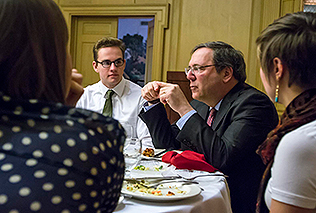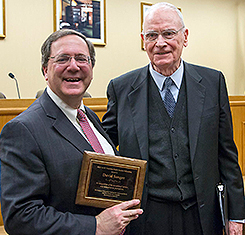Sanger describes reporting on Obama’s ‘secretive’ administration
Jessica Williams | March 29, 2013

Drones, cyberwarfare and managing government leaks weren’t new to the White House when President Barack Obama first took office, but the way the three strategies are handled reflect a changing philosophy in the current administration, according to David Sanger, author of Confront and Conceal: Obama’s Secret Wars and Surprising Use of American Power.
Sanger, who also is chief Washington correspondent for The New York Times, described how he developed and reported material for the book, relying on expertise honed over three decades of reporting and, more specifically, his years covering the White House.
His talk at the IU Maurer School of Law wrapped up the journalism school’s Speaker Series, and was co-sponsored by the IU Center on Congress and the IU Institute for Advanced Study.
Sanger called the Obama administration “one of the most secretive in history,” and this has raised flags for journalists.
“As a reporter, that’s what I cover: silences,” said the journalist who twice has been on teams that have won the Pulitzer Prize for the newspaper for investigative reporting.
Until recently, the administration had been silent on the use of drones, unmanned planes that can bomb strategic areas without risk to U.S. military. But sometimes the drones missed their mark, and, soon, the use of drones became a global discussion.
For the administration, dealing with the fallout from these errors presented a dilemma, Sanger said.
“If you can’t own up to them because you can’t admit to the drone program, you have a problem,” he said.
Sanger said cyberwarfare, or secretly dismantling infrastructure through viruses and programs, began under the second Bush administration. The Obama administration continued this, eventually launching what became known as Stuxnet, aimed at Iran’s nuclear program’s computerized process. Stuxnet became public when it began replicating around the world, thanks to an inadvertent change in the code.

Earlier in the day, Sanger talked with students over lunch. “You actually feel your mind expanding every day,” Sanger said of his life as a reporter. (Photo by Ben Wiggins)
Sanger also talked about the age-old practice of leaks, but these no longer are delivered in clandestine talks with informants. For example, Sanger described the Times’ debate to publish classified information and the process behind publishing some of the recent WikiLeaks discoveries, which included some 250,000 documents.
“A few of them had real secrets,” Sanger said, but about 20 percent were newspaper articles anyone could have read, which were marked “secret.”
The Times decided to work with between 100 and 150 documents and took the information to the federal government officials, giving them a heads-up on what was to be published and offering to negotiate publishing specifics if they were considered highly classified or dangerous for national security.
“They didn’t like the fact that we could make the final decision on that,” Sanger said.
But the process was successful as one item was removed from the stories regarding an embedded intelligence operative. The rest was published.
Sanger said he used this example to argue the need for a trusted channel between reporters and “a government serious about protecting what’s to protect,” not about exerting control.
That’s where the real conversation begins, he said, adding that it’s a tough balance to make.
Journalists work to tell readers what’s important while limiting the immediate harm they’ll create, he added.

“We won’t always be right, but we will always be trying,” he said.
After the talk, Sanger took questions from the audience. Then, School of Journalism Interim Dean Michael Evans presented Sanger with the Lee Hamilton Public Service Fellowship while former Rep. Lee Hamilton looked on. During his decades representing Indiana in Congress, Hamilton said he came to appreciate the importance of journalists to the democratic process, especially those like Sanger.
Earlier, Sanger spent the day on campus meeting with students. During a short lecture and question and answer session at lunch with journalism students and Hutton Honors students, Sanger said he appreciated students still pursuing journalism as a career, even with all the “disincentives” to do so.
It’s still a field that challenges its professionals, he said.
“You actually feel your mind expanding every day,” Sanger said.

